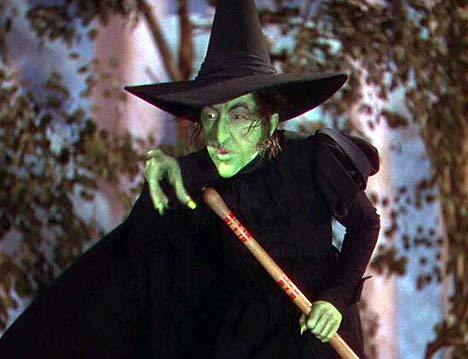As I mentioned in previous posts, greenness is not exclusively associated with villainy; there are also plenty of good green characters, from Robin Hood to the Green Lantern, in which the more positive associations of green are reflected. Above all, however, green characters are usually presented as a contrast with human protagonists - mysterious, alien or 'other' in some way. Green clothing has long been associated with the supernatural, and is often used as a literary shorthand to signify that a character is a fairy, witch, devil, or something in-between. Green skin, meanwhile, can be used as a clear marker of otherness in otherwise humanoid characters.
For the moment, however, I'm going to concentrate on characters which are either unambiguously villainous or monstrous. Over the next few posts I'll list (in no particular order) ten of the most dastardly, and greenest, villains...
Here are the first two:
1. The Lady of the Green Kirtle in The Silver Chair
 |
| Barbara Kellerman as the Lady in the BBC Chronicles of Narnia |
 |
| The Lady after transforming herself into a serpent, from the original illustrations by Pauline Baynes |
As a medievalist, Lewis was well aware of the symbolic properties of green, as well as the associative links in the Middle Ages between women, Eve and the serpent in the Garden of Eden, and his Lady owes a good deal to some of the more snakishly seductive temptresses of medieval romance (the host's wife in SGGK being a prime example).
The wonderful BBC miniseries of The Silver Chair (which I had on near-permanent loan from the library during the early 90s) does a great job of capturing the Lady's dual womanly and serpentine aspects, with actress Barbara Kellerman oscillating between velvet-gowned glamour and increasingly unhinged rage. Costume-wise, the snake-like coiled headdress she wears in the underworld scenes (shown above) is a nice touch, with the ivy-patterned veil a further nod to the dark, dank woodland associations of green.
2. The Wicked Witch of the West in The Wizard of Oz
 |
| Margaret Hamilton as the Wicked Witch of the West |

In the 1995 novel Wicked: The Life and Times of the Wicked Witch of the West, and the resulting hit musical Wicked, which retells the story from the witch's point of view, her green skin is explained (in the musical) as the result of a strange elixir which her mother drank whilst pregnant. Here her greenness is explored sympathetically as a feature which alienates her from those around her.
As a side note, The Wizard of Oz makes excellent use of the ambiguous nature of green to depict both sides of the colour, with the bejewelled spires of the Emerald City a dazzling counterpart to the murky green malevolence of the witch. More on this in a future post!
No comments:
Post a Comment